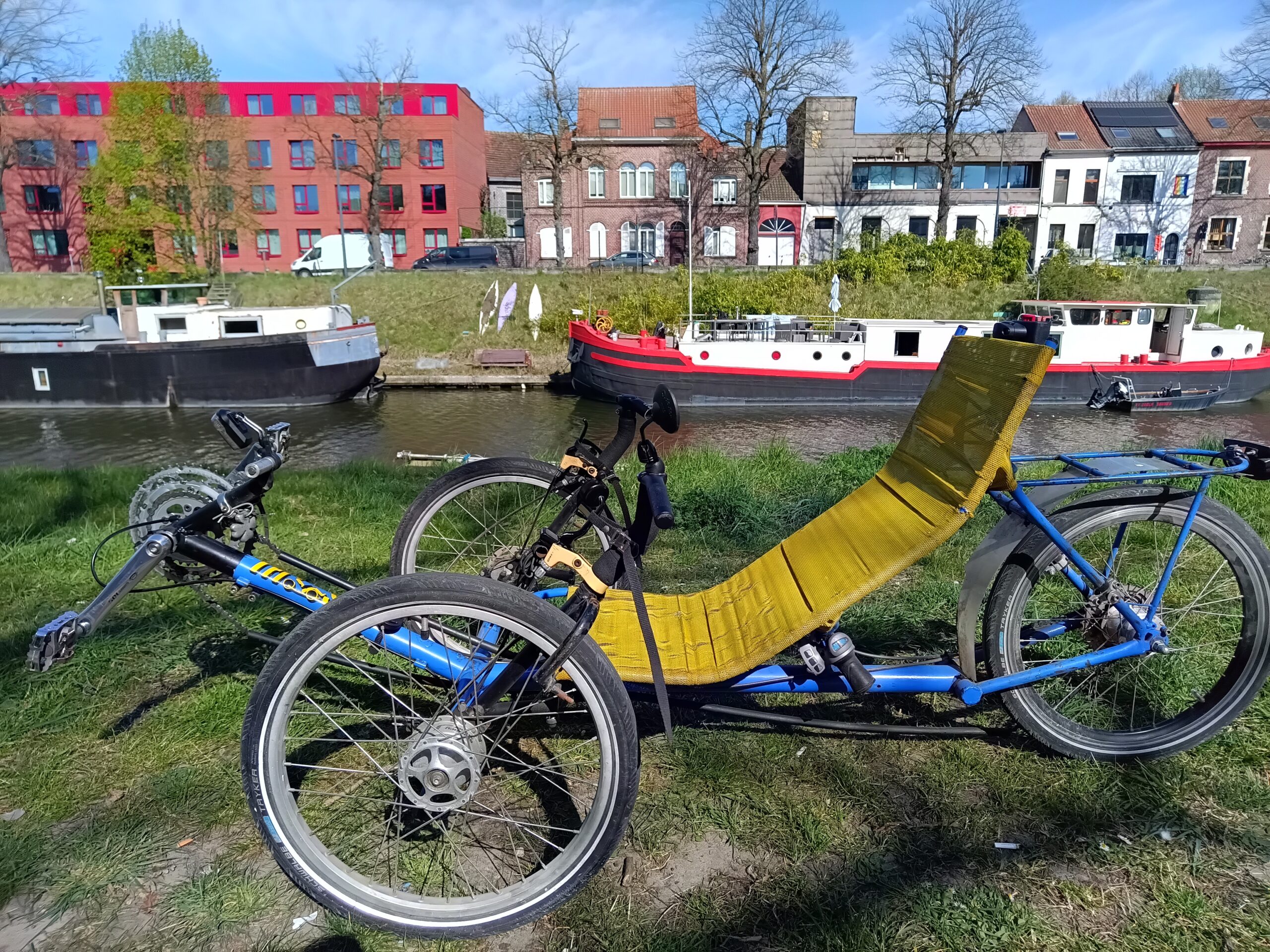🚴 Riding The Trike That Started It All: A (S)mile Through Recumbent History 🚴

🌱 Last Saturday, I rolled into the Fietser.be atelier in Ghent, excited to finally pick up my custom-made trailer. But what started as a practical visit quickly turned into an unforgettable (s)mile through time. What caught my eye first was a dream I had long fantasized about: the legendary Full Fat ICE Trike. But hidden behind it, almost like a secret waiting to be rediscovered, stood a true relic—Brecht’s first recumbent trike. A bright blue Trisled, bought all the way back in 2001 during his time in Australia. And yes, I got to test-ride it!
✅ A Technical Gem from the Early 2000s
This Trisled may be an oldtimer, but its setup is still impressive by any standard:
✅ 81-Speed Drivetrain – The Secret Weapon for Any Terrain
Yes, you read that right: 81 gears. That’s not a typo—it’s the result of a brilliantly engineered system designed to tackle everything from mountain climbs to coastal cruising.

At the heart of this trike’s setup is the legendary SRAM DualDrive 3, which combines two powerful gearing systems into one smooth-operating unit:
🔧 First, a 3-speed internal gear hub, integrated directly into the rear wheel.
🔁 Second, a classic 9-speed external cassette, mounted on the same hub.
Together, they deliver 3 × 9 = 27 gear combinations in the rear alone.
But that’s just the beginning.
Up front, the trike is equipped with a triple crankset, offering three different chainrings (for example, a 28T for easy climbing, a mid-size, and a 53T for powerful speed on flats). Multiply that by the 27 rear combinations, and you get:
3 (front) × 3 (hub) × 9 (cassette) = 81 unique gear ratios
💡 What does that mean on the road?
It means you always have the perfect gear at your fingertips. Whether you’re grinding your way up a steep forest trail, cruising effortlessly through quiet countryside lanes, or picking up speed on a smooth descent, this drivetrain adapts to you.
Even better? The internal hub lets you shift while standing still—a game-changer for stop-and-go city sections or sudden terrain changes on tour.
This isn’t just technical luxury—it’s touring freedom. With such a wide range, you save your legs on climbs, enjoy speed on the flats, and keep full control in unpredictable conditions. For long-distance trike riders, it’s a dream come true.
⚙️ Drum brakes – Smooth, strong, and still responsive after all these years.
🔧 Sturdy frame with rising handlebars – Unlike my ICE Sprint X, where I rest my arms low and relaxed, this one made me feel like I was riding a recumbent Harley Davidson. Okay, I’m exaggerating a bit—but my arms were definitely higher up. For short rides, fun. For long tours? My shoulders would protest.
🎒 No headrest—but with a twist – Instead of a headrest, Brecht placed a duffle bag holder behind the seat, using the bag as a makeshift pillow during rides. Challenge solved, old-school style.
💡 What Makes It Special?
Brecht still rides this trike today—and it shows. Despite its age, the Trisled feels alive, like a well-trained animal that hasn’t lost its spark. Every part of it tells a story: the slightly worn grips, the smooth click of the gear shift, the confident hum of the wheels on asphalt. It’s not just well-maintained—it’s loved. You sense that immediately.

But make no mistake: this machine isn’t just a nostalgic museum piece. It’s still technically refined, pleasantly agile, and immensely fun to ride. The moment I sat down in the yellow mesh seat, I could feel its character—solid, responsive, and ready to move.
🌀 And then there’s the steering.
It’s truly unlike anything I’ve ridden before. Compared to the relaxed, low-positioned handlebars on my ICE Sprint X, the rising bars on the Trisled gave the experience a whole different flavor. Think recumbent Harley Davidson—arms up, posture open, slightly rebellious. For short rides, it’s playful and engaging. For longer tours, I’d probably miss the low-hand rest comfort I’m used to. But that initial difference? Electrifying.
The steering responds not just to your hands, but to your entire body. Slight shifts in bodyweight are enough to guide the trike smoothly around curves. Once you get used to it, it feels almost intuitive—like the trike is reading your intentions. Brecht, after years of bonding with this beauty, rides it completely handsfree, navigating with nothing but balance and subtle motion.
It takes some getting used to, yes. At first, the responsiveness can feel almost too sharp, too direct—especially if you’re coming from modern touring trikes with more predictable steering dynamics. But once you surrender to it, once you stop controlling and start dancing with it, the ride becomes an experience.
This isn’t just cycling. It’s connection—between rider, machine, and the road beneath.
And that, I believe, is part of what makes this oldtimer so magical.
🔍 Who Is Trisled?
Trisled is a bold and innovative trike company based in Australia, known for pushing the boundaries of recumbent design. Since their founding, they’ve specialized in custom-built racing and touring trikes, velomobiles, and even record-breaking human-powered vehicles.
Their designs reflect not just speed and performance, but a kind of playful rebellion against the ordinary. This 2001 model I rode proves it: efficient, quirky, responsive, and built to last—over two decades and counting.
🏁 Final Thoughts
It was a true privilege to ride Brecht’s first trike—this Trisled isn’t just a machine; it’s a living piece of cycling history. It has traveled countless (s)miles, inspired the creation of Fietser.be, and remains a joy to ride to this day.
I came for a trailer, but left with a deeper appreciation for the roots of recumbent culture. Thank you, Brecht, for sharing your legend with me. 🙏

